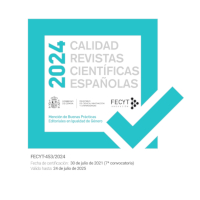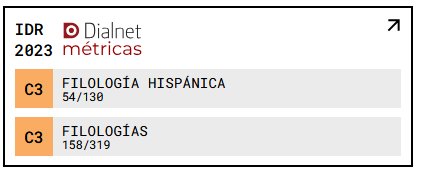Las variables afectivas en un programa de inmersión lingüística: un estudio cuantitativo
DOI:
https://doi.org/10.18172/cif.4385Palabras clave:
Variables afectivas, inmersión lingüística, educación primariaResumen
La inmersión lingüística ha cobrado mucha importancia durante las últimas décadas, ya que muchos estudiantes de todo el mundo se han beneficiado de esta experiencia tan motivadora. Por tanto, el objetivo principal de este estudio es determinar si una semana de inmersión en inglés tiene una influencia positiva en los niveles de motivación extrínseca e intrínseca, ansiedad en LE y los yoes en LE (Deci & Ryan 2000, Dörnyei, 2005, Horwitz, Horwitz & Cope 1991). Nuestros participantes son estudiantes de educación primaria (M: 11,5) que participaron en dicho programa. Estos cumplimentaron un cuestionario cuantitativo al llegar (test) y antes de terminar la semana (retest). Con el fin de comparar los resultados obtenidos en ambos momentos se utilizaron análisis ANOVA de un factor. Los resultados indicaron que después de la experiencia, la motivación aumenta, mientras que la ansiedad disminuye y la presencia de los yoes en los participantes se debilita.
Descargas
Citas
BAKER, S. C. and MACINTYRE, P. D. (2000). “The role of gender and immersion in communication and second language orientations”. Language Learning 50(2): 311-341. DOI: https://doi.org/10.1111/0023-8333.00119
BALE ROCA, S. B. (1980). “Applied linguistic, method and objectives in language teaching”. Cuadernos de investigación filológica (6): 53-62. DOI: https://doi.org/10.18172/cif.1439
BARCELOS, A. M. F. (2015). “Unveiling the relationship between language learning beliefs, emotions and identities”. Studies in Second Language Learning and Teaching 5(2): 301-325. DOI: https://doi.org/10.14746/ssllt.2015.5.2.6
CENOZ, J., GENESEE, F. and GORTER, D. (2014). “Critical analysis of CLIL: Taking stock and looking forward”. Applied linguistics 35(3): 243-262. DOI: https://doi.org/10.1093/applin/amt011
CLAVEL, B. and MARTÍ, M. M. (2008). “Second Language Acquisition”. In Working with words: An introduction to English linguistics. (Eds. M. Fuster and A. Sánchez). Universitat de Valéncia: Publicacions Universitat de Valéncia: 331-365.
COULOMBE, D. (2000). “Anxiety and beliefs of French-as-a-second-language learners at the university level”. Unpublished doctoral dissertation, University of Laval, Quebec, Canada.
CSIZÉR, K. and KORMOS, J. (2009). “Learning experiences, selves and motivated learning behaviour: A comparative analysis of structural models for Hungarian secondary and university learners of English”. In Motivation, language identity and the L2 self. (Eds. Z. Dörnyei and E. Ushioda). Bristol: Multilingual Matters: 98-119. DOI: https://doi.org/10.21832/9781847691293-006
DECI, E. L. and RYAN, R. M. (2000). “The 'what' and 'why' of goal pursuits: Human needs and the self-determination of behavior”. Psychological Inquiry 11(4): 227-268. DOI: https://doi.org/10.1207/S15327965PLI1104_01
DEWEALE J. M. (2011). “Reflections on the emotional and psychological aspects of foreign language learning and use”. Anglistik: International Journal of English Studies 22(1): 23-42.
DÖRNYEI, Z. (2005). The psychology of the language learner: Individual differences in second language acquisition. Mahwah, NJ: Lawrence Erlbaum.
DÖRNYEI, Z. (2009). “The L2 motivational self system”. In Motivation, language identity and the L2 self. (Eds. Z. Dörnyei and E. Ushioda). Bristol: Multilingual Matters: 9-42. DOI: https://doi.org/10.21832/9781847691293-003
DÖRNYEI, Z. and USHIODA, E. (2011). Teaching and researching motivation (2nd edition). Harlow: Pearson.
GARDNER, R. C. (2005). “Integrative Motivation and Second Language Acquisition”. http://publish.uwo.ca/wgardner/caaltalk5final.pdf (Accessed 01/04/2007).
GARDNER, R. C. (2010). Motivation and second language acquisition: The socio-educational model. New York, NY: Peter Lang Publishing.
GARRET, P. and YOUNG, R. (2009). “Theorising affect in foreign language learning: An analysis of one learner’s responses to a communicative Portuguese course”. The Modern Language Journal 93(2): 209-226. DOI: https://doi.org/10.1111/j.1540-4781.2009.00857.x
GRANT, S. (2018). “Effects of intensive EFL immersion programmes on willingness to communicate”. The language learning journal 46(1): 1-12.
FOSTER, P., BOLIBAUGH, C. and KOTULA, A. (2014). “Knowledge of nativelike selections in a L2: The influence of exposure, memory, age of onset, and motivation in foreign language and immersion settings”. Studies in Second Language Acquisition 36(1): 101-132. DOI: https://doi.org/10.1017/S0272263113000624
HORWITZ, E. K. (1983). Foreign language classroom anxiety scale. Unpublished manuscript. DOI: https://doi.org/10.1037/t60328-000
HORWITZ, E. K. et al. (1991). “Foreign language classroom anxiety”. In Language anxiety: From theory and research to classroom implications. (Eds. E. K. Horwitz and D. J. Young). Upper Saddle River, NJ: Prentice-Hall: 27-36.
KNELL, E., and CHI, Y. (2012). “The roles of motivation, affective attitudes, and willingness to communicate among Chinese students in early English immersion programs”. International Education 41(2): 5.
KRASHEN, S. D. (1982). Principles and practice in second language acquisition. Oxford: Pergamon Press.
MEARNS, T. L. (2012). “Using CLIL to enhance pupils’ experience of learning and raise attainment in German and health education: A teacher research project”. The Language Learning Journal 40(2): 175-192. DOI: https://doi.org/10.1080/09571736.2011.621212
MENECES DE OLIVEIRA E PAIVA, V. L. (2011). “Identity, motivation and autonomy in second language acquisition from the perspective of complex adaptive systems”. In Identity, motivation and autonomy in language learning. (Eds. G. Murray et al.). Bristol: Multilingual Matters: 57-72. DOI: https://doi.org/10.21832/9781847693747-006
Ó MUIRCHEARTAIGH, J. and HICKEY, T. (2008). “Academic outcome, anxiety and attitudes in early and late immersion in Ireland”.International Journal of Bilingual Education and Bilingualism 11(5): 558-576. DOI: https://doi.org/10.1080/13670050802149184
RYAN, S. (2009). “Self and identity in L2 motivation in Japan: The ideal L2 self and Japanese learners of English”. In Motivation, language identity and the L2 self. (Eds. Z. Dörnyei and E. Ushioda). Bristol: Multilingual Matters: 120-143. DOI: https://doi.org/10.21832/9781847691293-007
SAITO, Y. and SAMIMY, K. K. (1996). “Foreign language anxiety and language performance: A study of learner anxiety in beginning, intermediate, and advanced‐level college students of Japanese”. Foreign Language Annals 29(2): 239-249. DOI: https://doi.org/10.1111/j.1944-9720.1996.tb02330.x
TAGUCHI, T., MAGID, M. and PAPI, M. (2009). “The L2 motivational self system among Japanese, Chinese and Iranian learners of English: A comparative study”. In Motivation, language identity and the L2 self. (Eds. Z. Dörnyei and E. Ushioda). Bristol: Multilingual Matters: 66-97. DOI: https://doi.org/10.21832/9781847691293-005
TANAKA, Y. and KUTSUKI, A. (2018). “Motivation for learning English in the immersion environment of an international school in Japan”. International Journal of Bilingual Education and Bilingualism 21(6): 729-743. DOI: https://doi.org/10.1080/13670050.2016.1210566
USHIODA, E. (2012). “Motivation: L2 learning as a special case?”. In Psychology for Language Learner. (Eds. S, Mercer, S. Ryan, and M. Williams). Houndmills: Palgrave MacMillan: 58-73. DOI: https://doi.org/10.1057/9781137032829_5
WESELY, P. M. (2009). “The language learning motivation of early adolescent French immersion graduates”. Foreign Language Annals 42(2): 270-286. DOI: https://doi.org/10.1111/j.1944-9720.2009.01021.x
Descargas
Publicado
Cómo citar
Número
Sección
Licencia
El autor o autora conserva todos los derechos sobre su artículo y cede a la revista el derecho de la primera publicación, no siendo necesaria la autorización de la revista para su difusión una vez publicado. Una vez publicada la versión del editor el autor está obligado a hacer referencia a ella en las versiones archivadas en los repositorios personales o institucionales.
El artículo se publicará con una licencia Creative Commons de Atribución, que permite a terceros utilizar lo publicado siempre que se mencione la autoría del trabajo y la primera publicación en esta revista.
Se recomienda a los autores/as el archivo de la versión de editor en repositorios institucionales.














